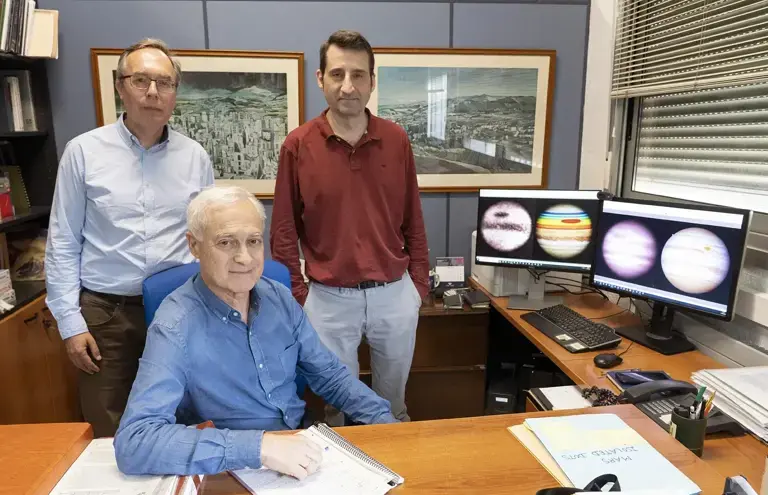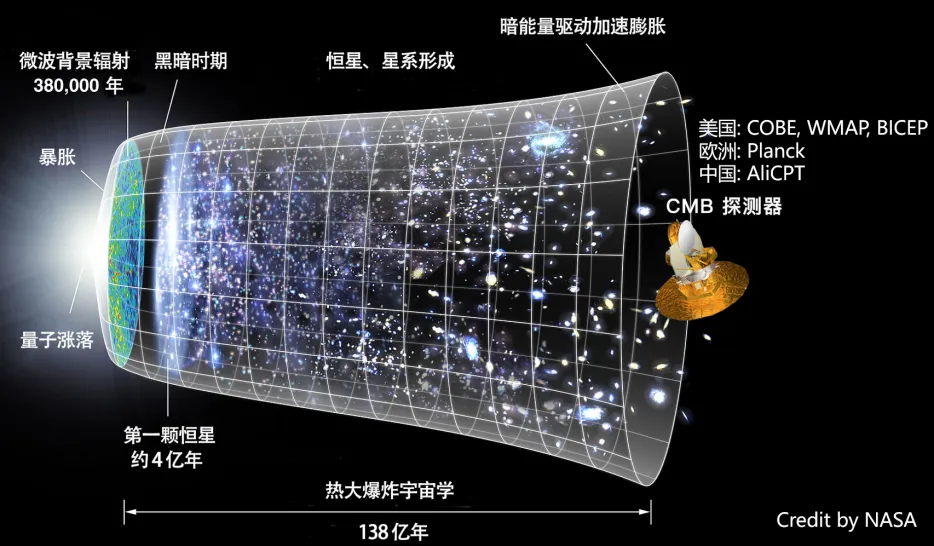太阳系最大的风暴:木星大红斑可能最终消失
木星大红斑是一个巨大的漩涡,已经存在了至少 190 年。最近的研究表明,它有别于早期观测到的红斑,模拟探索了木星风是如何塑造它的。木星红斑一直在缩小,未来的研究将侧重于它的可持续性和未来可能的解体。

木星大红斑(GRS)是一个很容易看到的反气旋漩涡,也是太阳系中最大的此类漩涡,自从几个世纪前首次通过望远镜观测到它以来,科学家们就对它产生了浓厚的兴趣。最近的研究,包括模拟和太空任务数据,对它的形成、稳定性以及未来缩小或消失的可能性进行了调查。资料来源:NASA、ESA、A. Simon(戈达德太空飞行中心)和 M.H. Wong(加州大学伯克利分校)
木星大红斑(GRS)是太阳系中最具标志性的特征之一。这个巨大的大气结构目前的直径相当于地球的直径,由于其醒目的红色,与木星苍白的云顶形成鲜明对比,因此很容易辨认出来。即使是小型望远镜也能捕捉到它的独特外观。GRS 是一个巨大的反气旋漩涡,其外缘的风速可达 450 公里/小时。它是太阳系所有行星大气层中规模最大、持续时间最长的漩涡。然而,GRS 的确切年龄仍有争议,其背后的形成过程仍是一个谜。
天文学家乔瓦尼-多梅尼科-卡西尼(Giovanni DomenicoCassini)在 1665 年首次用望远镜观测时,就发现了一个与地球同步卫星同纬度的暗椭圆形天体,并将其命名为"永久点"(PS),因为他和其他天文学家一直观测到 1713 年。
随后,它的踪迹消失了 118 年之久,直到 1831 年及以后,S. Schwabe 才再次观测到一个清晰的结构,大致呈椭圆形,与地球静止轨道位于同一纬度;这可以被视为对当前地球静止轨道的首次观测,或许是对新生地球静止轨道的观测。从那时起,一直到今天,人们通过望远镜和访问过地球的各种空间飞行任务定期对地球资源卫星进行观测。
在这项研究中,作者首先分析了它的大小随时间的演变、结构,以及前 PS 和 GRS 这两种气象形式的运动;为此,他们使用了可追溯到 17 世纪中叶(即望远镜发明后不久)的历史资料。

从左至右Enrique García-Melendo (UPC)、Agustín Sánchez Lavega 和 Jon Legarreta(UPV/EHU)。图片来源:Fernando Gómez.UPV/EHU
"根据对红斑大小和移动的测量,我们推断目前的红斑极有可能不是卡西尼观测到的红斑。红斑可能在 18 世纪中叶到 19 世纪之间的某个时候消失了,在这种情况下,我们可以说红斑现在的寿命至少超过了 190 年,"UPV/EHU 的物理学教授 Agustín Sánchez-Lavega 解释说,他是这项研究的负责人。1879 年,红斑最长轴的面积为 3.9 万公里,现在已经缩小到大约 1.4 万公里,同时变得更加圆润。
最新发现和模拟研究
此外,自 20 世纪 70 年代以来,多项太空任务对这一气象现象进行了密切研究。桑切斯-拉韦加解释说:"最近,环绕木星轨道运行的朱诺号任务所搭载的各种仪器显示,与水平尺寸相比,木星环流系统较浅且较薄,因为它的垂直长度约为 500 公里。"
为了弄清这个巨大漩涡是如何形成的,UPV/EHU 和 UPC 小组在西班牙超级计算机上进行了数值模拟,如西班牙超级计算网络(RES)中的 BSC MareNostrum IV,使用了木星大气中薄漩涡行为的两种互补模型。在这颗巨大的行星上,主要是沿平行线流动的强烈风流,其方向随纬度交替变化。在 GRS 的北面,风向为西风,时速为 180 公里;而在南面,风向则相反,为东风,时速为 150 公里。这就产生了巨大的南北风速切变,而这正是漩涡在其内部生长的基本要素。
在研究中,探索了一系列机制来解释地球同步卫星的成因,包括爆发巨大的超级风暴(类似于在孪生行星土星上很少观测到的超级风暴),或者风切变产生的多个较小涡旋的合并。结果表明,虽然在这两种情况下都会形成反气旋,但其形状和动态特性与目前的地球静止轨道不同。桑切斯-拉韦加说:"我们还认为,如果发生了其中一种不寻常的现象,当时的天文学家一定已经观测到并报告了它或它在大气层中的后果。"
数值模拟和未来研究
在第三组数值实验中,研究小组探索了风中一种已知的不稳定性如何产生 GRS,这种不稳定性被认为能够产生一个拉长的细胞,将它们包围并困住。这样一个细胞就是原地球同步卫星,一个新生的红斑,它随后的收缩将产生 19 世纪末观测到的紧凑而快速旋转的地球同步卫星。在木星上其他主要旋涡的形成过程中,已经观测到了大型细长细胞的形成。
UPC物理系研究员恩里克-加西亚-梅伦多(Enrique García-Melendo)说:"在我们的模拟中,超级计算机让我们发现,当拉长的细胞以木星风的速度围绕GRS外围旋转时,它们是稳定的。研究人员使用了两种不同类型的数值模型(一种在UPV/EHU,另一种在UPC),得出结论认为,如果原GRS的旋转速度低于周围风的旋转速度,原GRS就会破裂,从而无法形成稳定的漩涡。如果旋转速度非常高,原地球静止轨道的性质就会与当前的地球静止轨道不同。"
未来研究的目的是试图再现地球资源卫星随时间缩小的过程,以便更详细地了解其随时间持续存在的物理机制。同时,研究还将尝试预测 GRS 在达到一定大小极限时是否会解体和消失,就像卡西尼号 PS 可能发生的那样,或者它是否会稳定在一个大小极限上,从而可能会持续更多年。
编译自/scitechdaily
0 人喜欢
暂无评论,来发布第一条评论吧!

